DODGE VIPER SRT 2016 VX / 3.G Workshop Manual
Manufacturer: DODGE, Model Year: 2016, Model line: VIPER SRT, Model: DODGE VIPER SRT 2016 VX / 3.GPages: 427, PDF Size: 3.02 MB
Page 51 of 427
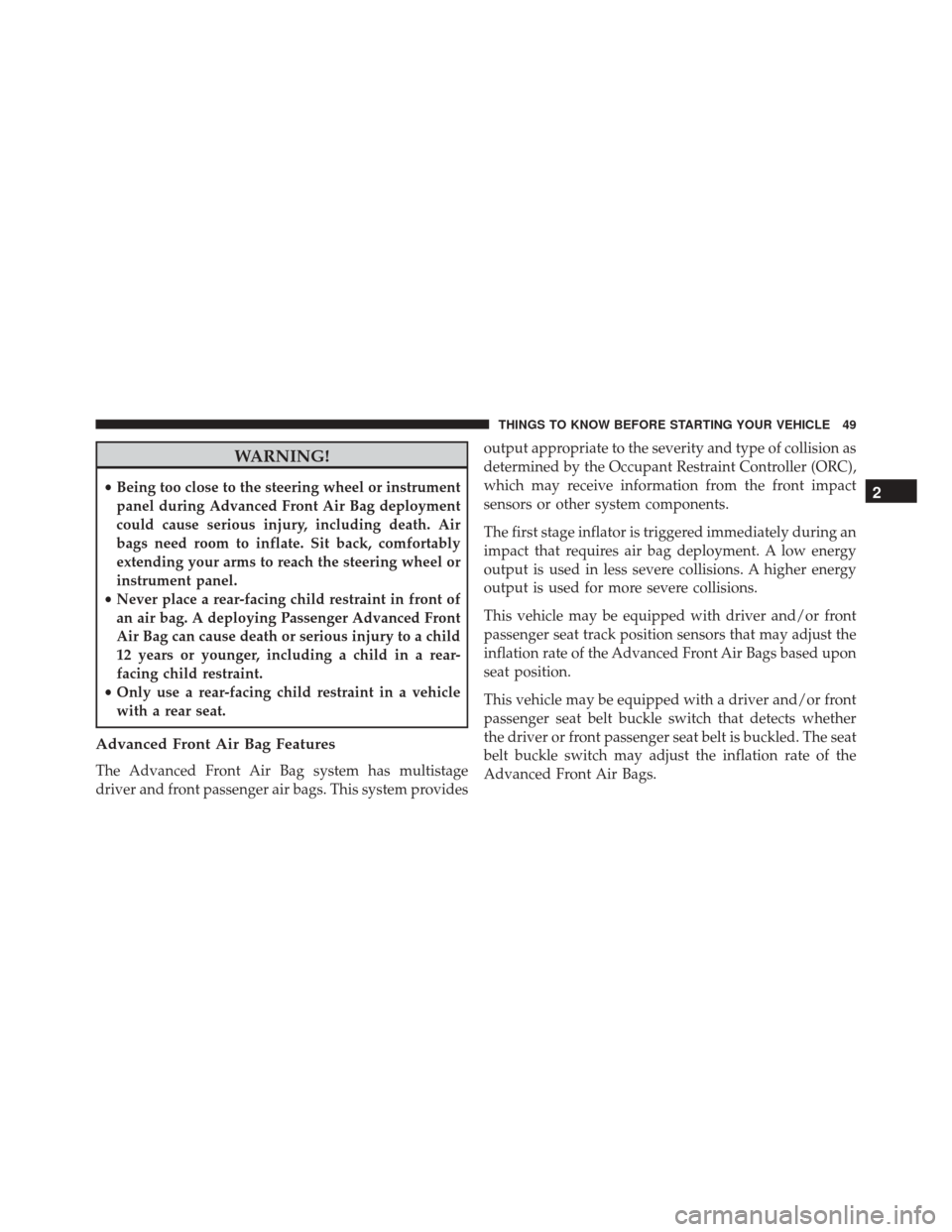
WARNING!
•Being too close to the steering wheel or instrument
panel during Advanced Front Air Bag deployment
could cause serious injury, including death. Air
bags need room to inflate. Sit back, comfortably
extending your arms to reach the steering wheel or
instrument panel.
• Never place a rear-facing child restraint in front of
an air bag. A deploying Passenger Advanced Front
Air Bag can cause death or serious injury to a child
12 years or younger, including a child in a rear-
facing child restraint.
• Only use a rear-facing child restraint in a vehicle
with a rear seat.
Advanced Front Air Bag Features
The Advanced Front Air Bag system has multistage
driver and front passenger air bags. This system provides output appropriate to the severity and type of collision as
determined by the Occupant Restraint Controller (ORC),
which may receive information from the front impact
sensors or other system components.
The first stage inflator is triggered immediately during an
impact that requires air bag deployment. A low energy
output is used in less severe collisions. A higher energy
output is used for more severe collisions.
This vehicle may be equipped with driver and/or front
passenger seat track position sensors that may adjust the
inflation rate of the Advanced Front Air Bags based upon
seat position.
This vehicle may be equipped with a driver and/or front
passenger seat belt buckle switch that detects whether
the driver or front passenger seat belt is buckled. The seat
belt buckle switch may adjust the inflation rate of the
Advanced Front Air Bags.
2
THINGS TO KNOW BEFORE STARTING YOUR VEHICLE 49
Page 52 of 427
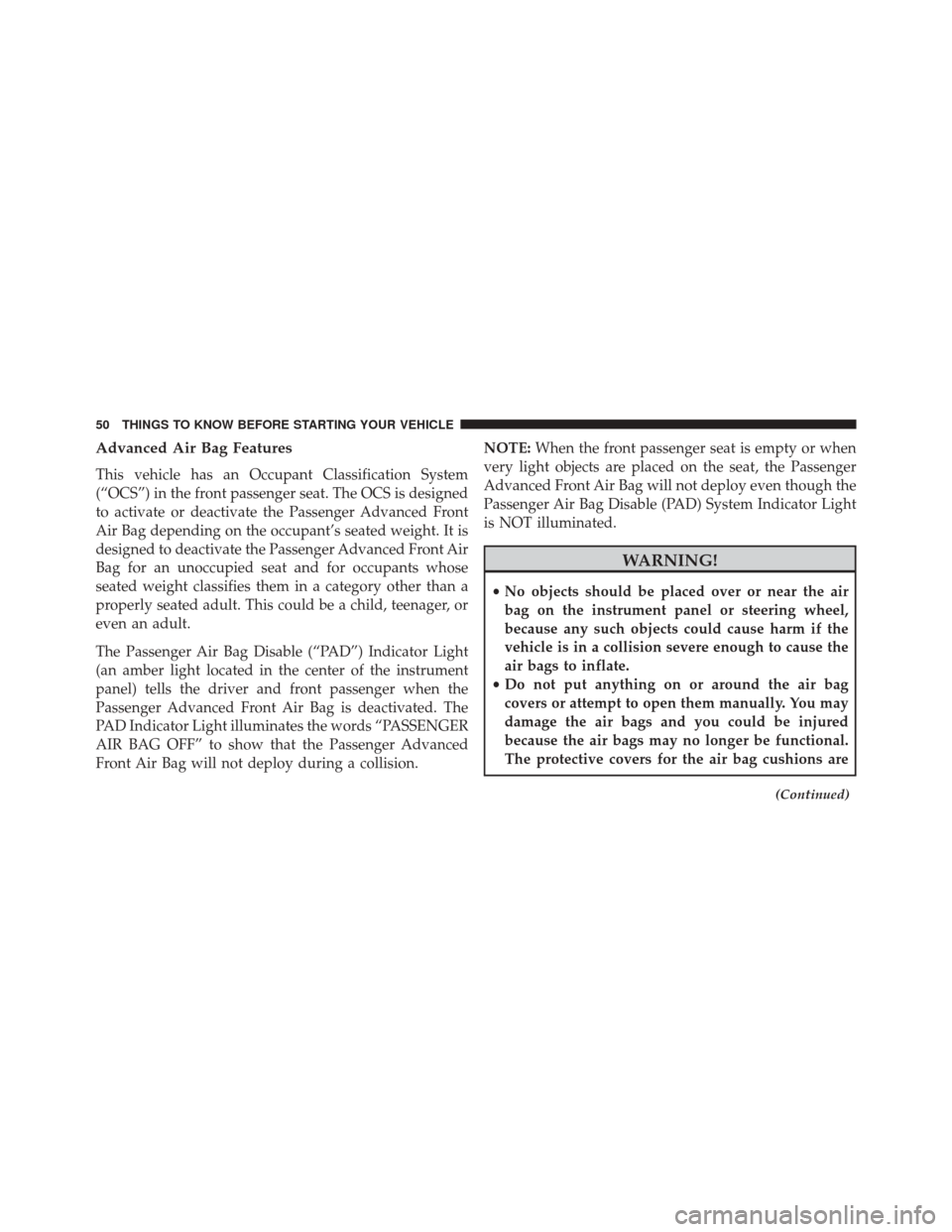
Advanced Air Bag Features
This vehicle has an Occupant Classification System
(“OCS”) in the front passenger seat. The OCS is designed
to activate or deactivate the Passenger Advanced Front
Air Bag depending on the occupant’s seated weight. It is
designed to deactivate the Passenger Advanced Front Air
Bag for an unoccupied seat and for occupants whose
seated weight classifies them in a category other than a
properly seated adult. This could be a child, teenager, or
even an adult.
The Passenger Air Bag Disable (“PAD”) Indicator Light
(an amber light located in the center of the instrument
panel) tells the driver and front passenger when the
Passenger Advanced Front Air Bag is deactivated. The
PAD Indicator Light illuminates the words “PASSENGER
AIR BAG OFF” to show that the Passenger Advanced
Front Air Bag will not deploy during a collision.NOTE:
When the front passenger seat is empty or when
very light objects are placed on the seat, the Passenger
Advanced Front Air Bag will not deploy even though the
Passenger Air Bag Disable (PAD) System Indicator Light
is NOT illuminated.
WARNING!
• No objects should be placed over or near the air
bag on the instrument panel or steering wheel,
because any such objects could cause harm if the
vehicle is in a collision severe enough to cause the
air bags to inflate.
• Do not put anything on or around the air bag
covers or attempt to open them manually. You may
damage the air bags and you could be injured
because the air bags may no longer be functional.
The protective covers for the air bag cushions are
(Continued)
50 THINGS TO KNOW BEFORE STARTING YOUR VEHICLE
Page 53 of 427
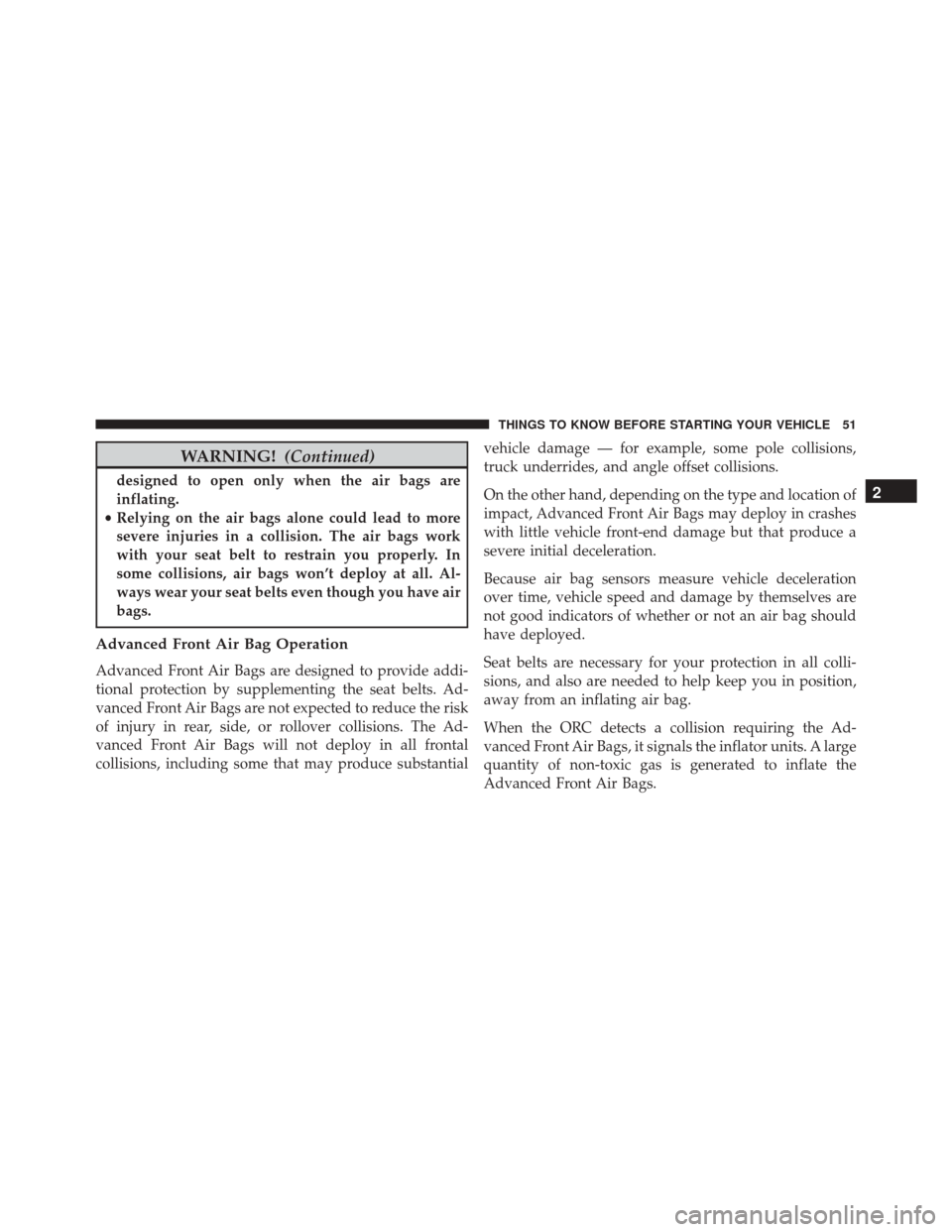
WARNING!(Continued)
designed to open only when the air bags are
inflating.
• Relying on the air bags alone could lead to more
severe injuries in a collision. The air bags work
with your seat belt to restrain you properly. In
some collisions, air bags won’t deploy at all. Al-
ways wear your seat belts even though you have air
bags.
Advanced Front Air Bag Operation
Advanced Front Air Bags are designed to provide addi-
tional protection by supplementing the seat belts. Ad-
vanced Front Air Bags are not expected to reduce the risk
of injury in rear, side, or rollover collisions. The Ad-
vanced Front Air Bags will not deploy in all frontal
collisions, including some that may produce substantial vehicle damage — for example, some pole collisions,
truck underrides, and angle offset collisions.
On the other hand, depending on the type and location of
impact, Advanced Front Air Bags may deploy in crashes
with little vehicle front-end damage but that produce a
severe initial deceleration.
Because air bag sensors measure vehicle deceleration
over time, vehicle speed and damage by themselves are
not good indicators of whether or not an air bag should
have deployed.
Seat belts are necessary for your protection in all colli-
sions, and also are needed to help keep you in position,
away from an inflating air bag.
When the ORC detects a collision requiring the Ad-
vanced Front Air Bags, it signals the inflator units. A large
quantity of non-toxic gas is generated to inflate the
Advanced Front Air Bags.
2
THINGS TO KNOW BEFORE STARTING YOUR VEHICLE 51
Page 54 of 427
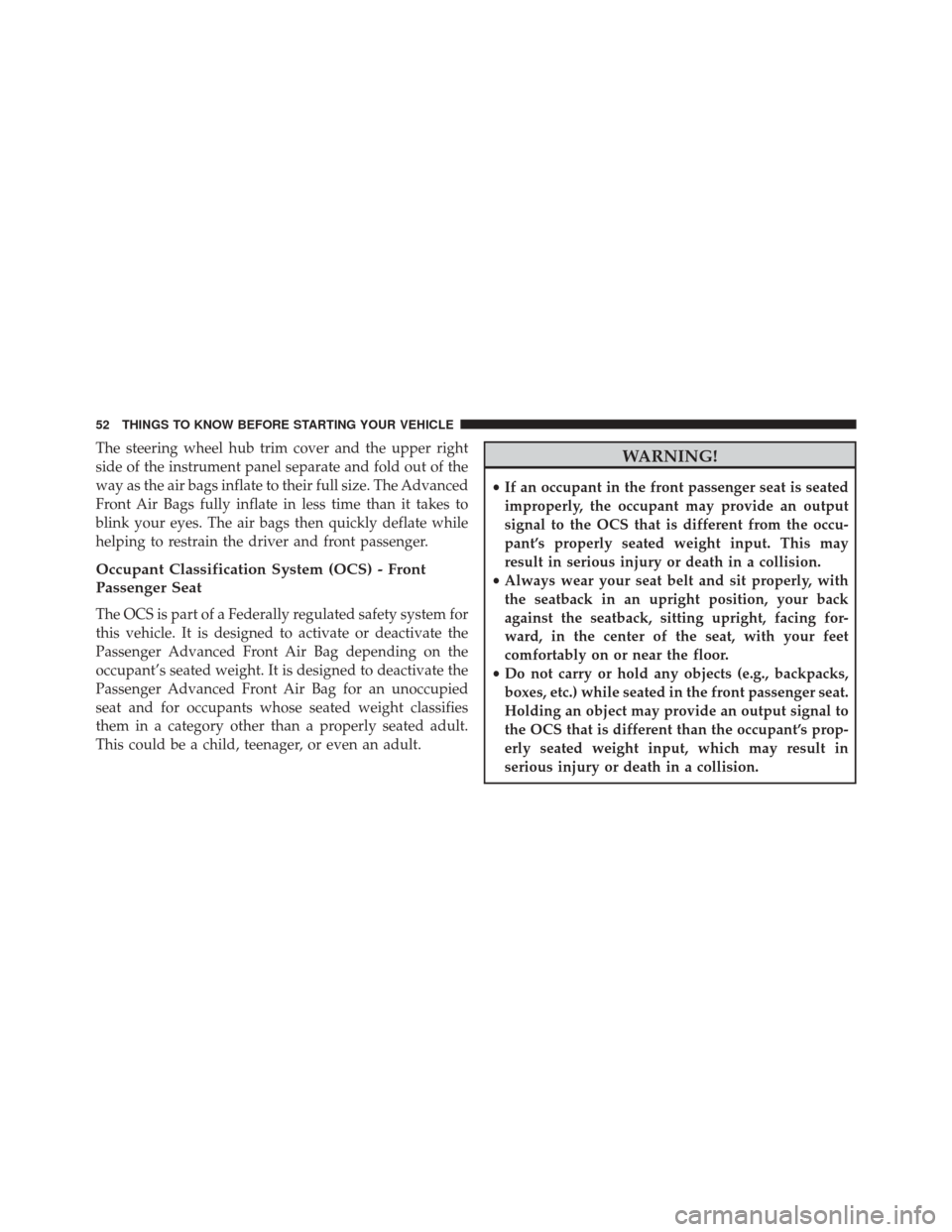
The steering wheel hub trim cover and the upper right
side of the instrument panel separate and fold out of the
way as the air bags inflate to their full size. The Advanced
Front Air Bags fully inflate in less time than it takes to
blink your eyes. The air bags then quickly deflate while
helping to restrain the driver and front passenger.
Occupant Classification System (OCS) - Front
Passenger Seat
The OCS is part of a Federally regulated safety system for
this vehicle. It is designed to activate or deactivate the
Passenger Advanced Front Air Bag depending on the
occupant’s seated weight. It is designed to deactivate the
Passenger Advanced Front Air Bag for an unoccupied
seat and for occupants whose seated weight classifies
them in a category other than a properly seated adult.
This could be a child, teenager, or even an adult.
WARNING!
•If an occupant in the front passenger seat is seated
improperly, the occupant may provide an output
signal to the OCS that is different from the occu-
pant’s properly seated weight input. This may
result in serious injury or death in a collision.
• Always wear your seat belt and sit properly, with
the seatback in an upright position, your back
against the seatback, sitting upright, facing for-
ward, in the center of the seat, with your feet
comfortably on or near the floor.
• Do not carry or hold any objects (e.g., backpacks,
boxes, etc.) while seated in the front passenger seat.
Holding an object may provide an output signal to
the OCS that is different than the occupant’s prop-
erly seated weight input, which may result in
serious injury or death in a collision.
52 THINGS TO KNOW BEFORE STARTING YOUR VEHICLE
Page 55 of 427
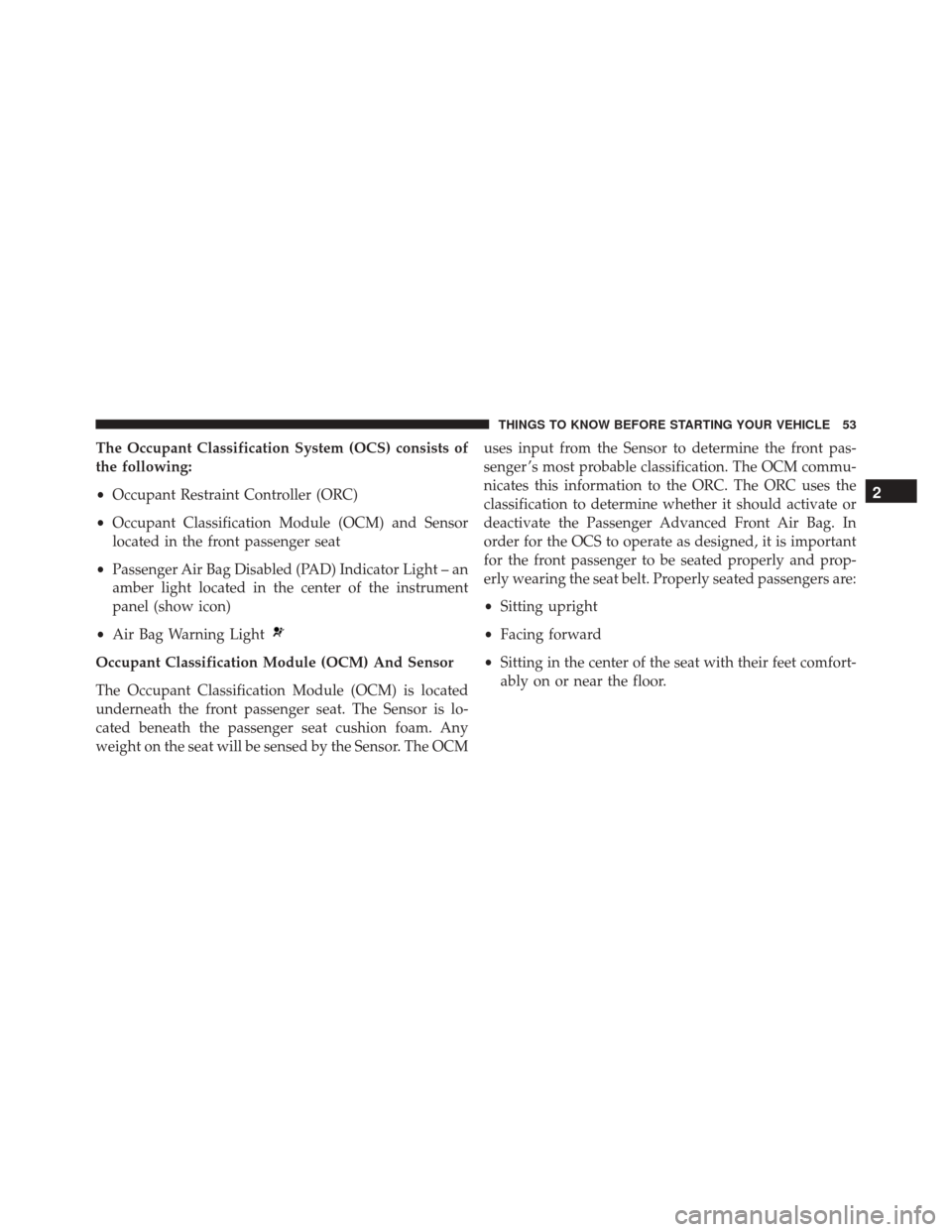
The Occupant Classification System (OCS) consists of
the following:
•Occupant Restraint Controller (ORC)
• Occupant Classification Module (OCM) and Sensor
located in the front passenger seat
• Passenger Air Bag Disabled (PAD) Indicator Light – an
amber light located in the center of the instrument
panel (show icon)
• Air Bag Warning Light
Occupant Classification Module (OCM) And Sensor
The Occupant Classification Module (OCM) is located
underneath the front passenger seat. The Sensor is lo-
cated beneath the passenger seat cushion foam. Any
weight on the seat will be sensed by the Sensor. The OCM uses input from the Sensor to determine the front pas-
senger ’s most probable classification. The OCM commu-
nicates this information to the ORC. The ORC uses the
classification to determine whether it should activate or
deactivate the Passenger Advanced Front Air Bag. In
order for the OCS to operate as designed, it is important
for the front passenger to be seated properly and prop-
erly wearing the seat belt. Properly seated passengers are:
•
Sitting upright
• Facing forward
• Sitting in the center of the seat with their feet comfort-
ably on or near the floor.
2
THINGS TO KNOW BEFORE STARTING YOUR VEHICLE 53
Page 56 of 427
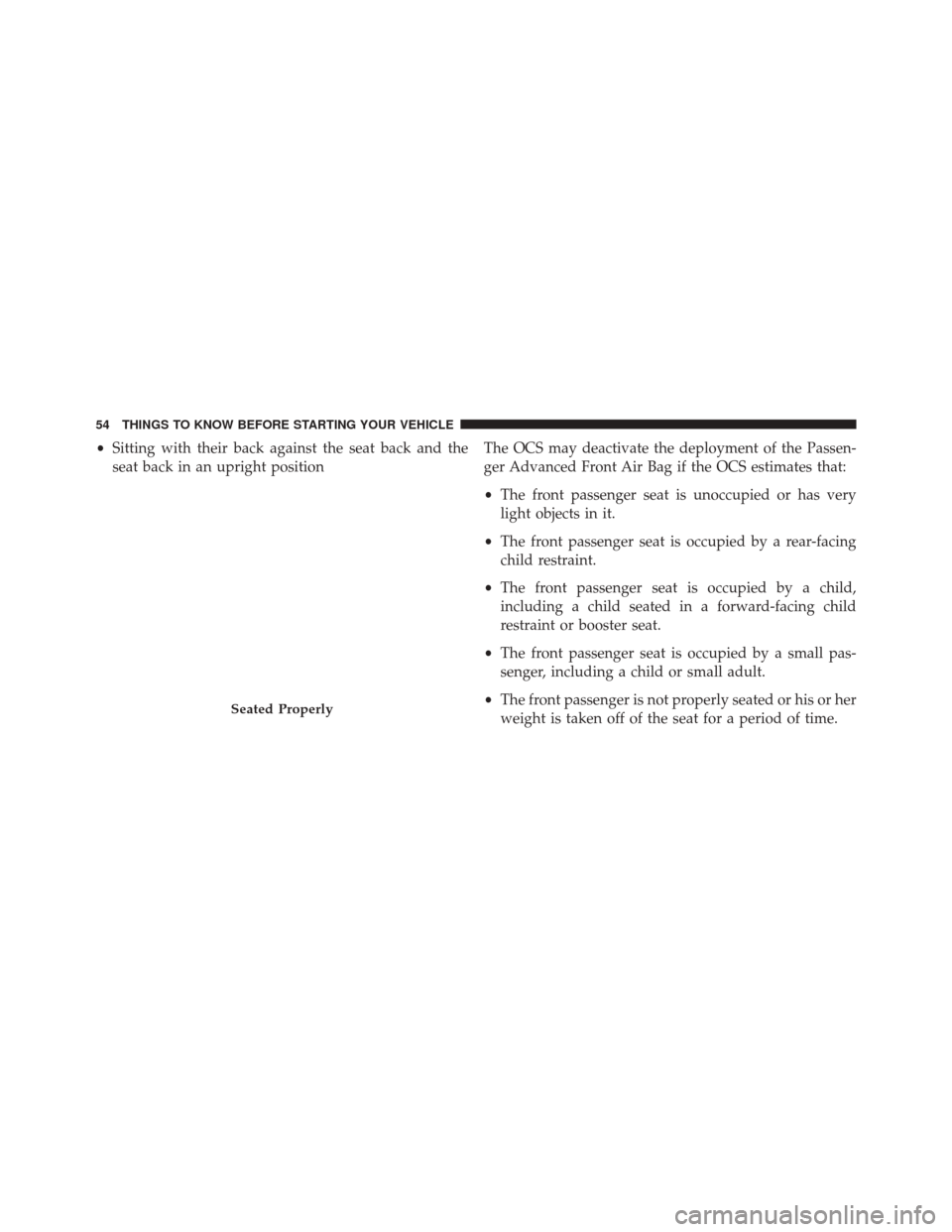
•Sitting with their back against the seat back and the
seat back in an upright position The OCS may deactivate the deployment of the Passen-
ger Advanced Front Air Bag if the OCS estimates that:
•
The front passenger seat is unoccupied or has very
light objects in it.
• The front passenger seat is occupied by a rear-facing
child restraint.
• The front passenger seat is occupied by a child,
including a child seated in a forward-facing child
restraint or booster seat.
• The front passenger seat is occupied by a small pas-
senger, including a child or small adult.
• The front passenger is not properly seated or his or her
weight is taken off of the seat for a period of time.
Seated Properly
54 THINGS TO KNOW BEFORE STARTING YOUR VEHICLE
Page 57 of 427
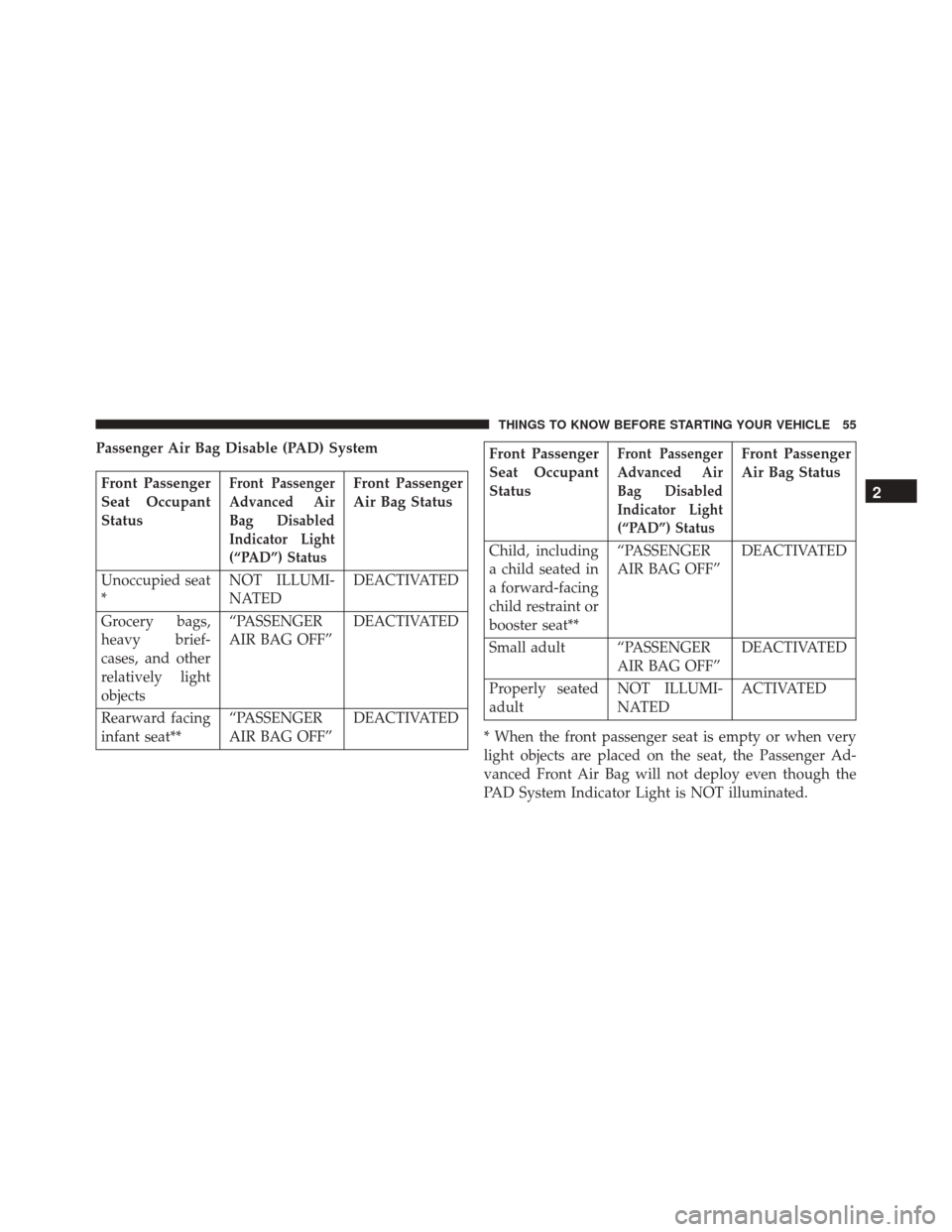
Passenger Air Bag Disable (PAD) System
Front Passenger
Seat Occupant
StatusFront Passenger
Advanced Air
Bag Disabled
Indicator Light
(“PAD”) StatusFront Passenger
Air Bag Status
Unoccupied seat
* NOT ILLUMI-
NATEDDEACTIVATED
Grocery bags,
heavy brief-
cases, and other
relatively light
objects “PASSENGER
AIR BAG OFF”
DEACTIVATED
Rearward facing
infant seat** “PASSENGER
AIR BAG OFF”DEACTIVATED
Front Passenger
Seat Occupant
StatusFront Passenger
Advanced Air
Bag Disabled
Indicator Light
(“PAD”) StatusFront Passenger
Air Bag Status
Child, including
a child seated in
a forward-facing
child restraint or
booster seat** “PASSENGER
AIR BAG OFF”
DEACTIVATED
Small adult “PASSENGER AIR BAG OFF”DEACTIVATED
Properly seated
adult NOT ILLUMI-
NATEDACTIVATED
* When the front passenger seat is empty or when very
light objects are placed on the seat, the Passenger Ad-
vanced Front Air Bag will not deploy even though the
PAD System Indicator Light is NOT illuminated.
2
THINGS TO KNOW BEFORE STARTING YOUR VEHICLE 55
Page 58 of 427
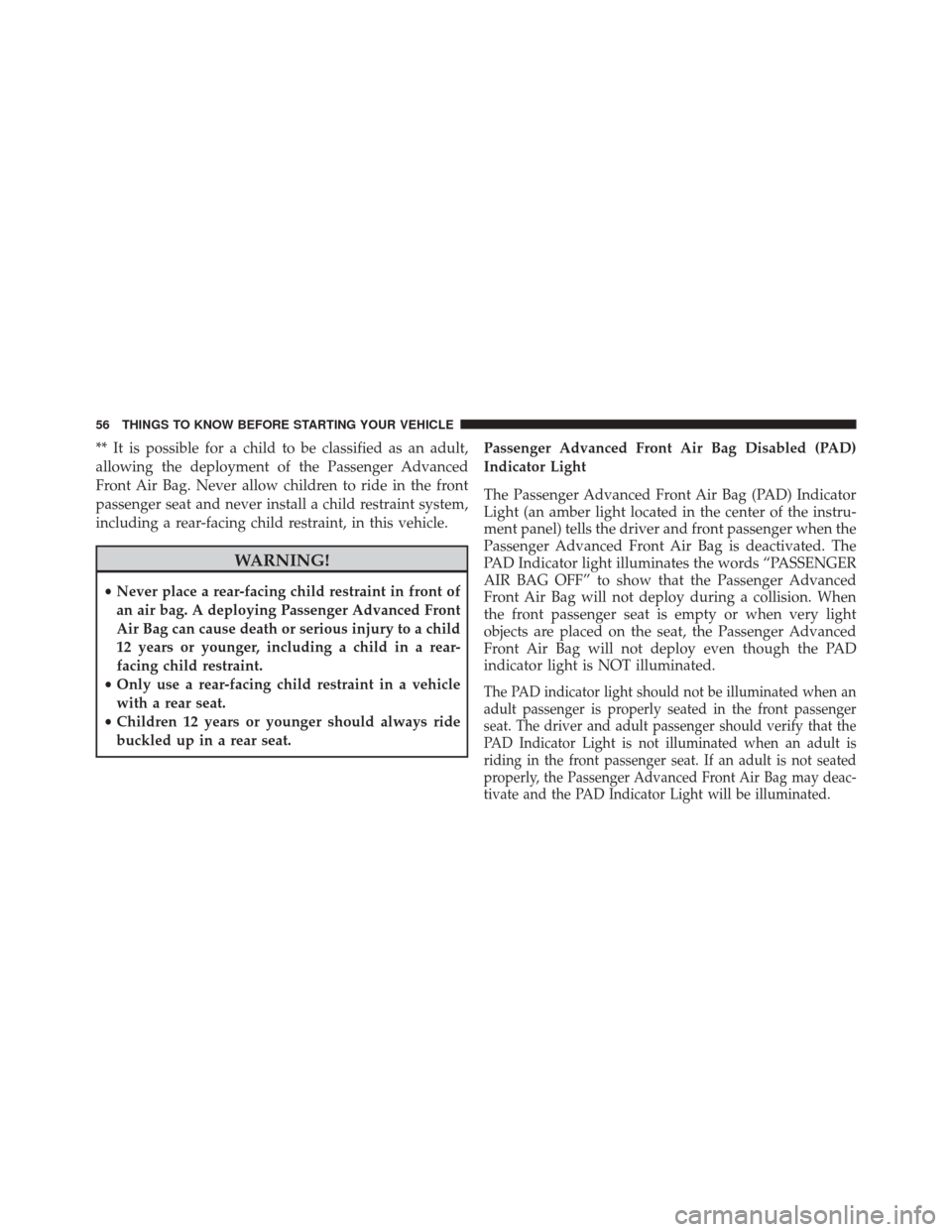
** It is possible for a child to be classified as an adult,
allowing the deployment of the Passenger Advanced
Front Air Bag. Never allow children to ride in the front
passenger seat and never install a child restraint system,
including a rear-facing child restraint, in this vehicle.
WARNING!
•Never place a rear-facing child restraint in front of
an air bag. A deploying Passenger Advanced Front
Air Bag can cause death or serious injury to a child
12 years or younger, including a child in a rear-
facing child restraint.
• Only use a rear-facing child restraint in a vehicle
with a rear seat.
• Children 12 years or younger should always ride
buckled up in a rear seat. Passenger Advanced Front Air Bag Disabled (PAD)
Indicator Light
The Passenger Advanced Front Air Bag (PAD) Indicator
Light (an amber light located in the center of the instru-
ment panel) tells the driver and front passenger when the
Passenger Advanced Front Air Bag is deactivated. The
PAD Indicator light illuminates the words “PASSENGER
AIR BAG OFF” to show that the Passenger Advanced
Front Air Bag will not deploy during a collision. When
the front passenger seat is empty or when very light
objects are placed on the seat, the Passenger Advanced
Front Air Bag will not deploy even though the PAD
indicator light is NOT illuminated.
The PAD indicator light should not be illuminated when an
adult passenger is properly seated in the front passenger
seat. The driver and adult passenger should verify that the
PAD Indicator Light is not illuminated when an adult is
riding in the front passenger seat. If an adult is not seated
properly, the Passenger Advanced Front Air Bag may deac-
tivate and the PAD Indicator Light will be illuminated.
56 THINGS TO KNOW BEFORE STARTING YOUR VEHICLE
Page 59 of 427
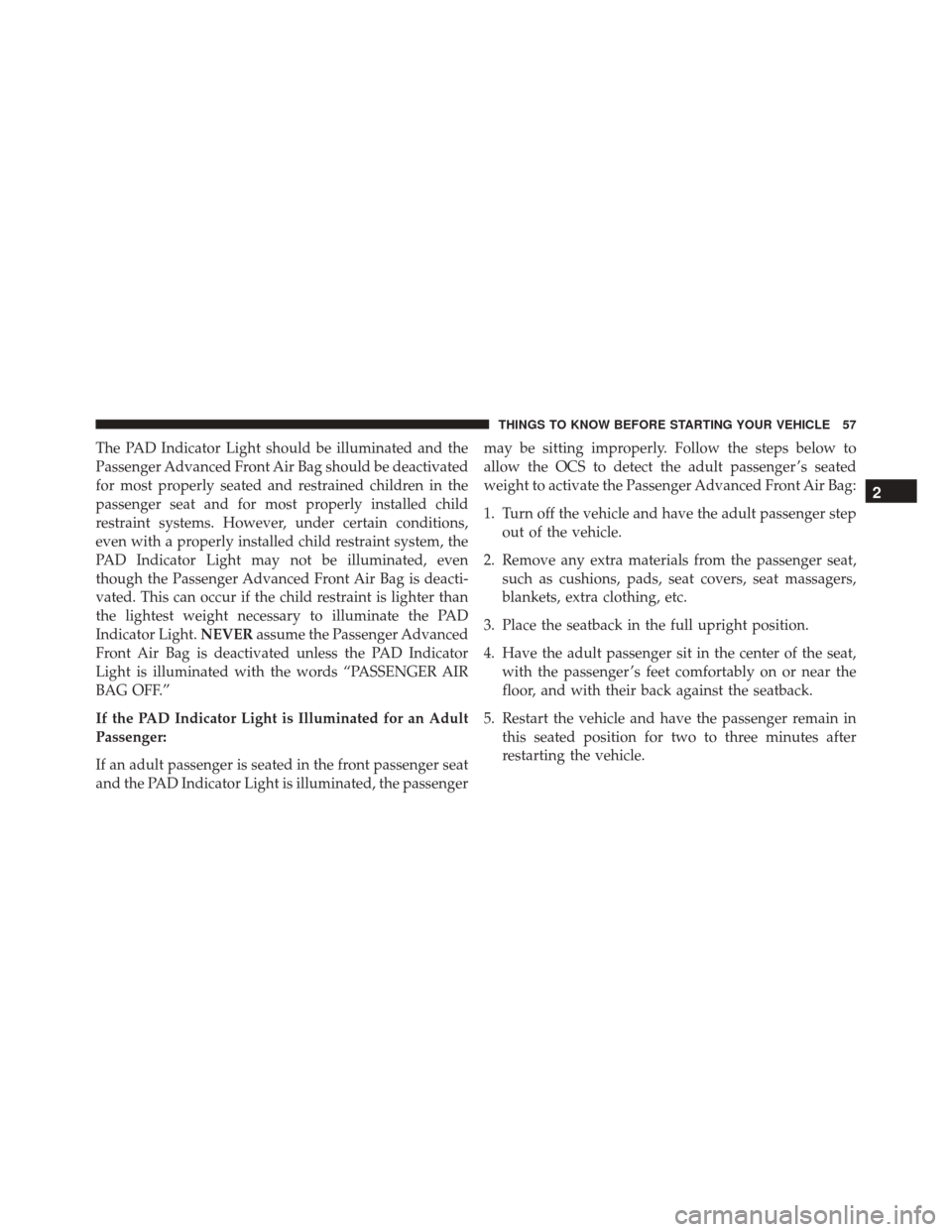
The PAD Indicator Light should be illuminated and the
Passenger Advanced Front Air Bag should be deactivated
for most properly seated and restrained children in the
passenger seat and for most properly installed child
restraint systems. However, under certain conditions,
even with a properly installed child restraint system, the
PAD Indicator Light may not be illuminated, even
though the Passenger Advanced Front Air Bag is deacti-
vated. This can occur if the child restraint is lighter than
the lightest weight necessary to illuminate the PAD
Indicator Light.NEVERassume the Passenger Advanced
Front Air Bag is deactivated unless the PAD Indicator
Light is illuminated with the words “PASSENGER AIR
BAG OFF.”
If the PAD Indicator Light is Illuminated for an Adult
Passenger:
If an adult passenger is seated in the front passenger seat
and the PAD Indicator Light is illuminated, the passenger may be sitting improperly. Follow the steps below to
allow the OCS to detect the adult passenger ’s seated
weight to activate the Passenger Advanced Front Air Bag:
1. Turn off the vehicle and have the adult passenger step
out of the vehicle.
2. Remove any extra materials from the passenger seat, such as cushions, pads, seat covers, seat massagers,
blankets, extra clothing, etc.
3. Place the seatback in the full upright position.
4. Have the adult passenger sit in the center of the seat, with the passenger ’s feet comfortably on or near the
floor, and with their back against the seatback.
5. Restart the vehicle and have the passenger remain in this seated position for two to three minutes after
restarting the vehicle.
2
THINGS TO KNOW BEFORE STARTING YOUR VEHICLE 57
Page 60 of 427
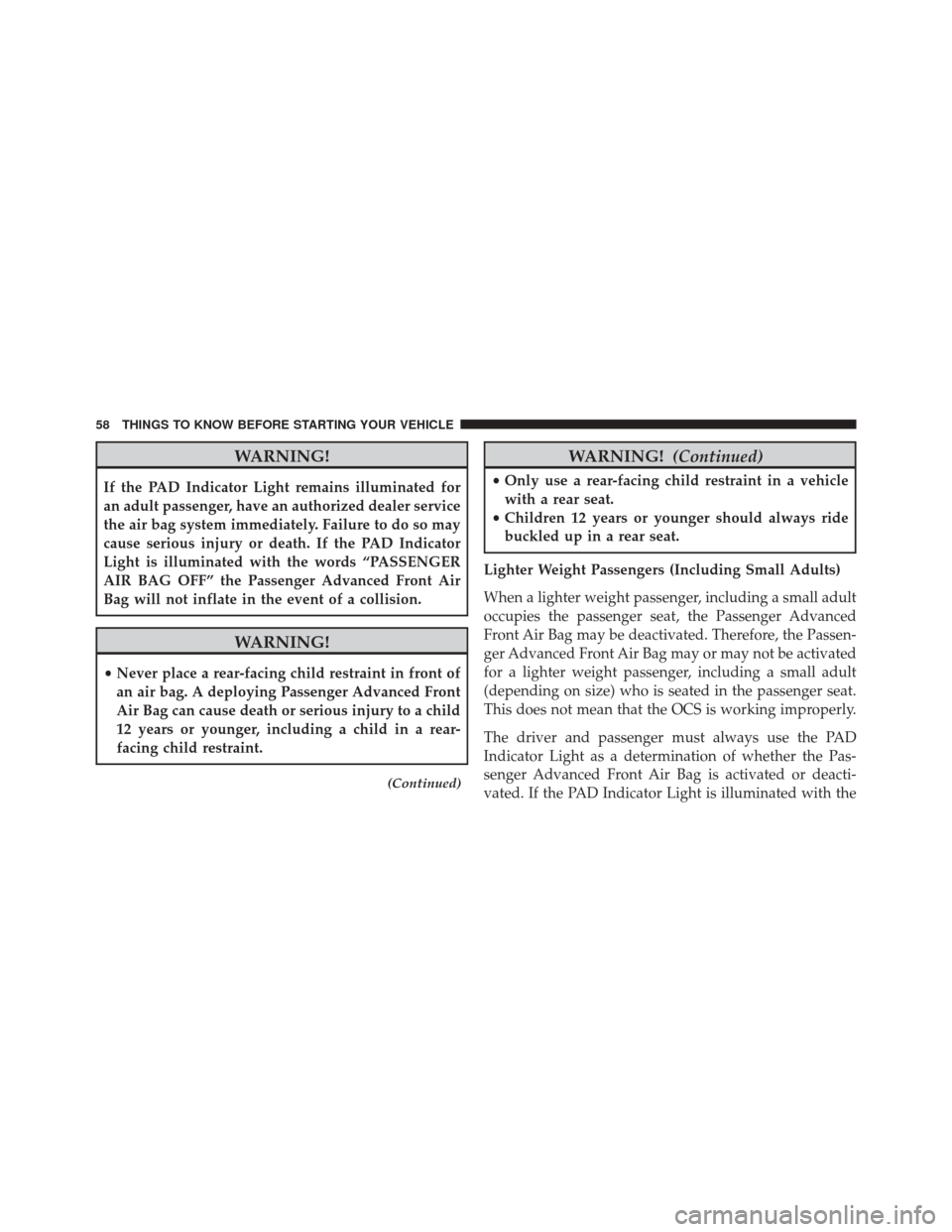
WARNING!
If the PAD Indicator Light remains illuminated for
an adult passenger, have an authorized dealer service
the air bag system immediately. Failure to do so may
cause serious injury or death. If the PAD Indicator
Light is illuminated with the words “PASSENGER
AIR BAG OFF” the Passenger Advanced Front Air
Bag will not inflate in the event of a collision.
WARNING!
•Never place a rear-facing child restraint in front of
an air bag. A deploying Passenger Advanced Front
Air Bag can cause death or serious injury to a child
12 years or younger, including a child in a rear-
facing child restraint.
(Continued)
WARNING! (Continued)
•Only use a rear-facing child restraint in a vehicle
with a rear seat.
• Children 12 years or younger should always ride
buckled up in a rear seat.
Lighter Weight Passengers (Including Small Adults)
When a lighter weight passenger, including a small adult
occupies the passenger seat, the Passenger Advanced
Front Air Bag may be deactivated. Therefore, the Passen-
ger Advanced Front Air Bag may or may not be activated
for a lighter weight passenger, including a small adult
(depending on size) who is seated in the passenger seat.
This does not mean that the OCS is working improperly.
The driver and passenger must always use the PAD
Indicator Light as a determination of whether the Pas-
senger Advanced Front Air Bag is activated or deacti-
vated. If the PAD Indicator Light is illuminated with the
58 THINGS TO KNOW BEFORE STARTING YOUR VEHICLE